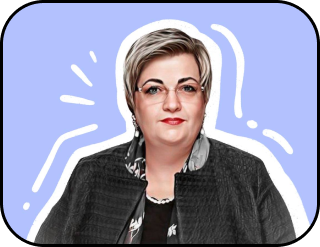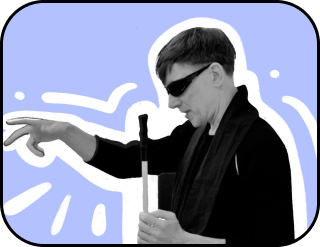Category: Global minds
Without Legs, But Standing Tall. Global Confession of a Global Figure. Victoria Korolyova
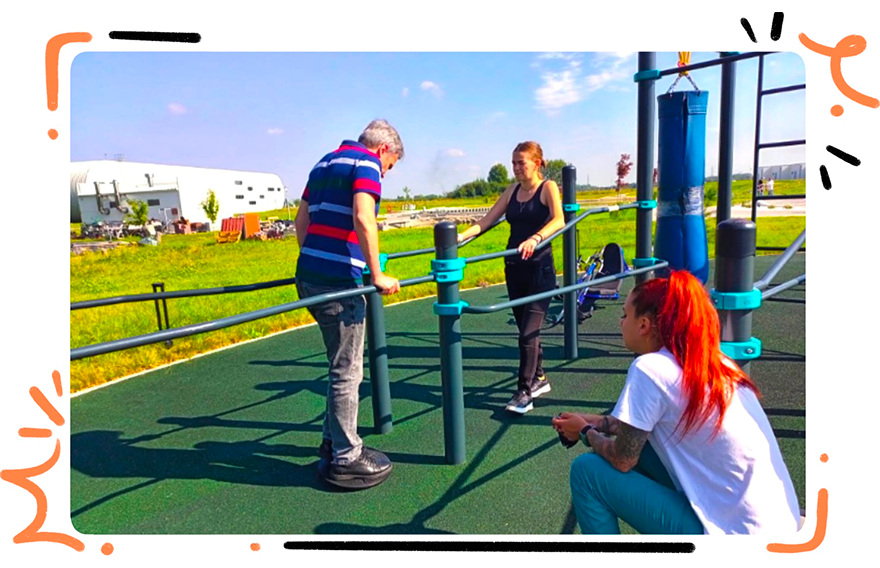
Life isn’t always a straight road bathed in sunlight. Sometimes it twists so sharply that sudden drops force you to learn how to walk all over again, and loss makes you gather up the remaining pieces of yourself, one by one. But it’s in those breaking points that real, raw, unpolished human stories are born.
The heroine of this interview is a fragile young woman who knows the price of both rising and falling — quite literally. She doesn’t wear a superhero cape; her “costume” is made of scars, prosthetics, and an extraordinary inner strength.
There was a time she thought life was over — no more morning runs, no more awkward dancing in the kitchen, not even the simple act of “getting up and walking.” Life switched tracks and demanded she follow cruel new rules: first, learn to find balance in a hospital bed, then on prosthetic legs, and then — in the ocean of other people’s stares. And she did learn. She learned how to be fragile and still undefeated — and then went on to teach those left without support how to love life endlessly.
This interview is not a motivational speech.It’s an honest conversation — about the kind of fear that chokes you in the middle of the night, about anger toward a world that feels unfair, about the moments when you truly say goodbye to life. It’s about parents who gave her wings. About patients who can barely move — yet teach strength and resilience. And about a strange kind of magic: when you help someone else stand up, you somehow stop feeling broken yourself.
Answering our questions is Victoria Victorovna Korolyova – Chair of the Regional Office of the All-Russian Public Organization “Opora” (an association for people with limb amputations and other musculoskeletal impairments), rehabilitation specialist, instructor in Adaptive Physical Education (APE), and walking school instructor at the prosthetics and orthotics company Lider Protezirovaniya.
— Victoria, thank you so much for agreeing to do this interview. You often share your story. What do you want people to remember after meeting you?
— I don’t share my story to get sympathy. Once, I spoke with a very experienced psychologist who runs a huge number of training sessions, and she told me: “What you’ve lived through in just a few years — most people don’t go through in a lifetime.”
I’ve had three clinical deaths. Three times, I was in extremely critical condition — and each time, I pulled through it essentially on my own.
— Let’s start from the beginning, then. One day you woke up, and your body was different.
— After COVID, my diabetes worsened sharply — and then I got pregnant. Unfortunately, everything unfolded in a very severe scenario. At 24 weeks of pregnancy, my kidney failed, and for three days I was hanging between life and death. The doctors literally brought me back from the brink — but my daughter passed away on the second day.
That same period, my first husband left me. Turned out he’d had another family for almost a year already. And from there, everything just spiraled down: in August, my kidney failed.
In December, I had my first amputation,and a year later, in December 2022, I had the second one. You know what I say now? “They amputated everything unnecessary from my life along with my legs.”
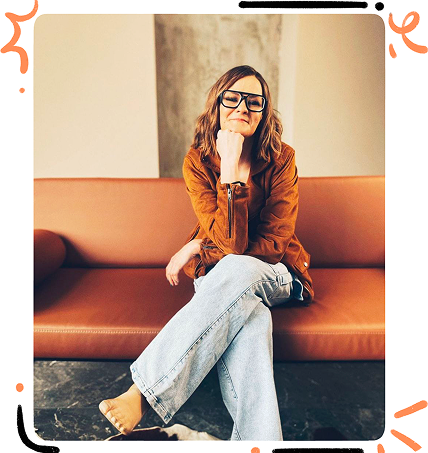
— It seems like you remember that time with a sense of gratitude. Is that even possible?
— That whole situation stripped my life down to zero — completely.
All the friends who used to say they’d walk through fire and water for me — they were the first to disappear. And then something really strange happened: on December 16, 2022, my phone suddenly shut off. Just like that, out of nowhere.
My old photos, contacts — nothing could be recovered. It was as if my whole previous life got erased. As if fate itself said: “From here on, only forward. No more dead weight.”
— What did you feel in that moment, when everything was reset?
— Emptiness. But not a scary one — a lighter kind of emptiness. On December 29, I was discharged from the hospital. And that was it. Zero. A new page. There was this strange sensation: as if all the pain had left my life — and silence settled in.
I’ve always been a naturally positive person. My mom taught me that no matter what happens, you should try to find something good. Do you know what I said when they were wheeling me in for my first amputation?
— No.
— I joked: “Well, at least now I won’t have to buy shoes anymore.”
Dark humor? Yes. But it helps.
— Who or what gave you the strength to keep coming back?
— My parents, who were always by my side. Since childhood, I’ve always felt like I had to be the one supporting them, not the other way around.So I always tried to get back on my feet — not even for myself, but to make things a little easier for them. I needed to stand so they wouldn’t fall.
— At the very beginning of our conversation, you said that fate didn’t let you die for a reason. Do you really feel that way?
— Absolutely. If I was left here a third time, then it means I’m still needed for something. It means my time hasn’t come yet. And if I’m still here — then I have to live.
I’m definitely not the kind of person who just sits and waits for something to fall from the sky. Of course it was hard. I talked a lot with my mom — she really tried to support me, to think of something, to lift me up.
— As far as I know, you wanted to become a doctor even before the amputations?
— I’ve always been that kind of person: “If I can help — I will.” Even if I don’t want to. Even if it’s hard. But if someone asks — I’ll step up and do it. That’s how I was raised.
Our family is from the Leningrad region — my parents and grandparents survived the Siege of Leningrad. In our family, helping others was just what you did. My mom or dad could pay for someone’s groceries in a store, help carry a bag, give someone a ride. For me, it became normal — something natural.
That’s probably why I went into medicine. Working as a general practitioner didn’t excite me much — I always needed adrenaline, life, movement. So I made a firm decision to become a surgeon.
I studied to be a doctor, got my higher medical education — but then everything changed suddenly. I had a clinical death — I was unconscious for almost 13 minutes. After that, my mentor doctors told me I could no longer be the kind of surgeon I dreamed of becoming. And that’s how I ended up in emergency medical services.
And I can say for sure: I found myself in that work. I worked in EMS for eight years — 24-hour shifts, every other day. And it had everything: the calls, the exhaustion, the helplessness. I worked out in the region — in Baltiysk and the town of Svetly. And working in the region is nothing like working in the city. In the city, everything is close: hospitals, doctors, emergency teams. Out there, you’re on your own. You are the diagnosis, the hands, the decision-maker. Childbirth, car crashes, trauma — everything had to pass through you.
— Victoria, you mentioned that the amputation and the critical events leading up to it happened in 2022. That means not much time passed before you started saving other people’s lives again?
— Right. The time between my own critical condition and the moment I was already saving lives was minimal.I was given exactly one month after I was discharged from the hospital — just a month to sit at home, feel sorry for myself, and rest. It was around the New Year holidays, and exactly a month later, I was already going out into the city in my wheelchair.
Everyone called me “the little monkey” because I had no legs, but I still had knees — I would climb into the taxi by myself, transfer into the wheelchair by myself.
— Did anyone help you with rehabilitation?
— No. At that time, there weren’t any rehabilitation specialists in the team who could help with that. I went through everything on my own.It used to be like this: they’d bring someone in with an amputated limb, hand them their prosthetic, and send them home. That’s what happened with me — I got my prosthetic, came in for the fitting, they adjusted it, and just said: “Go.” I walked between the parallel bars twice — that was it.
Now, in Central Russia, rehabilitation specialists have started to appear, because there’s finally demand.People have started to understand that those with amputated limbs need help — they need support. But back then, rehab specialists were almost nonexistent.
— How did you come to the profession of a rehabilitation specialist?
— It all started with a cup of coffee, actually. I needed to go to a prosthetic center to handle some paperwork. I ended up chatting with the girls at the front desk — they were practically strangers to me at the time, but they were so kind, and not a hint of pity in their eyes. Just genuine curiosity, humor, and warmth. We laughed and joked like we’d known each other forever.
I also started volunteering at the prosthetic center — taking photos, posting things on their social media, talking to the patients. It felt good just to be helpful — for no reason, just because I could.
And then… that was it. We became friends. We started working together.

— So it turns out you started helping others even before you were officially invited?
— Exactly. And that’s probably the most genuine kind of help — when you simply can’t not help. When you just care.
Later, the director of the prosthetic company, Vitaly Evgenievich Morozkin, found out that I was a medical professional and invited me for a conversation. He said: “You’ve been through all of this yourself. Would you like to become a rehabilitation specialist — to help others get up and walk on prosthetics?”
And something just clicked in my head: this is it. This is why I was kept alive. This is what I had been searching for. And I immediately said: “Yes, Vitaly Evgenievich. I really do.”
And that was it. They started sending me to trainings, to seminars, to Ottobock — a company that’s been making products for people with limb loss for many years — and to conferences. Now I hold two diplomas: one as an instructor of adaptive physical education and sports, and another in medical rehabilitation. It wasn’t easy, but it was incredibly meaningful.
— What’s the most important part of your work with people who have undergone amputations?
— Right now, I’m the only rehabilitation specialist in the Kaliningrad region who works specifically with amputees. And that’s a very unique and delicate area.
Because the most important part of this work isn’t even physical activity. The key is to teach someone how to live again.
As long as a person feels that their prosthetic is a “foreign object,” they won’t be able to fully live with it. And my job is to help them accept their new self — exactly as they are: alive, and real.
— What’s the hardest part about accepting a new life with prosthetics?
— Until you accept that these are your legs, you will never truly walk. The prosthetics will feel uncomfortable, restrictive — they’ll seem ugly. You’ll be embarrassed by them, try to hide them.
The brain only stops resisting when it understands: “Yes, these are my legs. I love them. I’m grateful to them for letting me walk.” That’s when the brain accepts the new reality.
— So rehabilitation doesn’t start with physical exercises?
— It all begins with a struggle. First — with the internal “why?” Honestly, some of the exercises look ridiculously silly at first. Some people see them and say, “What is this, kindergarten?”
But as the rehab process moves forward, everything begins to make sense.Still, resistance always comes first: “Why do I even need this?”
If a person is asking questions — that’s great.And if they follow through and actually do what I tell them — then it works. Everything moves quickly, smoothly, and correctly from there.
— It’s a very difficult path, isn’t it: first accept, then believe, and only then walk?
— Absolutely.
— I imagine you have specific methods to help make some of these steps a little easier?
— I often tell my patients: Imagine that your body is like a computer, and you need to reinstall Windows.
When the brain loses a limb, it loses a whole fragment of its internal software. The control system crashes. The brain blocks off that area — it’s just blank, nothing there. Now, in that empty space, we have to write in the prosthetic — as part of you.
The brain doesn’t feel the prosthetic — it doesn’t know what to do with it. So it tries to protect you. You take a step, and your brain says, “Stop! You’re about to fall!” That’s why even standing up is so hard in the first few months. Because the brain thinks the body has no support — and gently lets you fall to the floor.
So our job is to install the prosthetic into the brain’s system and tell it: “I have a leg. It works. Everything is okay.” It sounds simple, but in reality, every session is a huge battle with yourself.
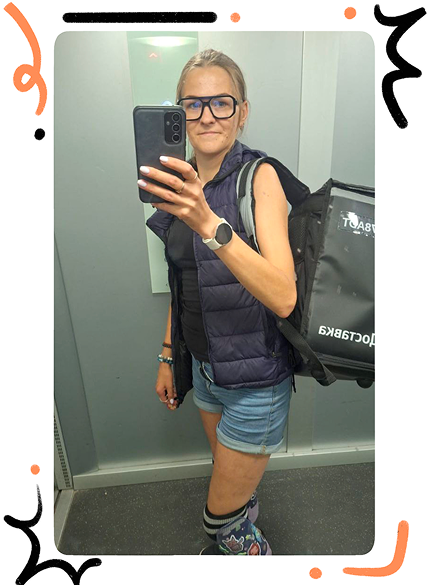
— Let’s talk about your patients. Have there been any whose progress you’re especially proud of?
— I could talk about my patients forever. For example, there was a man with a thigh-level amputation. He came to me and said: “I have a vegetable garden. I love fishing. I need to get back on my feet.” We did just seven sessions together. After the last one, he walked away with a single cane — and now he walks 20 kilometers a day, works in his garden, and even gets off the bus one stop early on purpose just to walk the extra distance.
And by the way — he’s 70 years old! But he had the will. He didn’t want to remember his garden — he wanted to work in it.
Desire — that’s everything.No pills, no exercises, no doctors will help if you don’t have that inner word: “I must.” Nothing will work without a solid mindset: “I want to. I will stand up. I will walk.”
There was another case: also a man, also with a thigh-level amputation, after a serious car accident. The problem was that his other leg had no knee joint at all — it was completely immobile, not weight-bearing. The doctors handed him off to me with a smile: “You like tough cases, right? Here you go — try this one.”
And guess what? Six months later, he was standing. We managed to rehabilitate his bad leg enough for him to walk. He started out with crutches — and now he walks on a prosthetic thigh. Sure, the knee will need to be replaced eventually, but now he can do that — because the prosthetic leg became his new support.
He did every single exercise without complaining, without saying “I’ll do it tomorrow.” And that’s the only reason he succeeded.
— But I guess not all cases go like that?
— Of course not. Unfortunately, there are other cases too. People say things like: “You can’t teach me. I can’t do it.” Then I ask: “Are you practicing at home? Show me the exercises you’ve been doing.” And suddenly — silence.
— What do you say to them in moments like that?
— You weren’t lying to me. You were lying to yourself.
— Why is it so hard for some people to get started?
— It’s simple — they don’t have a goal, especially young guys. They lie there, staring at the ceiling, thinking: “I’m disabled, nobody needs me, I don’t want to go anywhere.”
Right now, I’m working with two such guys — they even share a hospital room. Both from Luhansk, both grew up in an orphanage. Same age, same background. But one of them has stood up, and the other is still learning how to bandage himself.
Because one of them has a goal — to get back to his comrades, the guys he fought with, the ones he grew up with. He does everything I tell him. The other one got lost. We met when he was just lying in the hospital, with no will to live, no dreams. We sat and talked for two and a half hours. He doesn’t even need a psychologist. People like him need someone who will listen, who will find one thread in all that pain and pull on it.
Since February, I’ve been working with him: brought him bandages, showed him how to use them, explained why. It took half a year before he learned to do it himself.
— So it’s not about physical condition at all?
— Exactly. It’s an inner process. If it were just about muscles and joints, I’d just run the scheduled sessions and move on. But every person is a unique system, and each has their own path to recovery.
With some, you have to be strict: “Step left, step right — follow the command!” Others need warmth instead. I’d explain walking differently even to twins, because each brain processes movement in its own way. Sometimes I have to squat down, put a person in parallel bars, and move their legs with my hands to help them take the first step. Because until the signal passes from body to brain, nothing will happen.
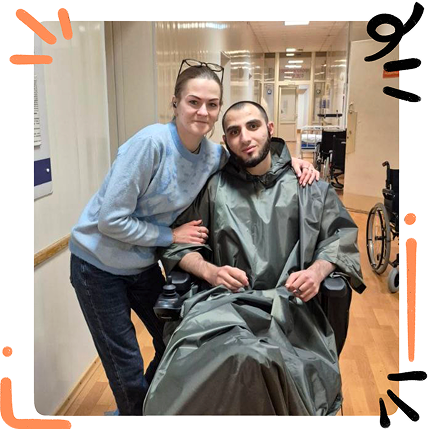
— So the main thing isn’t the program, but the approach to the person?
— Exactly. There’s no magic tape playing mantras: “Five sessions and you’ll walk.” That won’t happen. Each person is a unique story, a unique psyche, unique pain — and most importantly, a unique meaning. Without meaning, you won’t get up.
— You said that even you, as a rehabilitation specialist, didn’t immediately understand how it all works. How come?
— Yes, I’m a doctor myself and I went through all this, and I didn’t understand what I was doing wrong. I had 21 surgeries under anesthesia in two years — and that’s just counting the major ones.
— That’s an incredible number.
— I’m not talking about the local treatment when they open it up, clean it, and stitch it. But just imagine: what is it like for people who have never dealt with this at all?
It all started when they began fitting me with prosthetics. At first, they spent a year and a half looking for the right ones. Then I walked on them, wore out my stump, and went back to the hospital. I’d get discharged, walk for two weeks, and then start over again. It was some kind of endless cycle.
Until one day I realized I was doing something wrong. I started digging deeper, asking prosthetists, reading everything I could, analyzing every little detail. And only when I finally found the solution did everything begin to change.
Or recently, I changed my prosthetic feet. Before that, I had been walking on others for two years. The new feet are soft, polycentric, and I got up into the parallel bars by myself — but I still didn’t understand what I needed to do next. My brain simply didn’t know how to react because the load with these feet is completely different. Until the brain “reflashed,” my body was also in a stupor.
— Victoria, thank you so much for sharing the hard truth with us, no sugarcoating. And in that regard, I have a question: it’s clear everyone has their own struggles, but what is the hardest thing for you right now?
— You know, I can’t even say what is the hardest thing for me. Since childhood, I’ve had this kind of character — to go where it’s difficult. Honestly, now it’s hard even to imagine something that could scare me.
Well, actually, there is one thing. I really wouldn’t want to upset my parents. My mom and dad — they are my greatest support: for their sake, I get up in the morning, for their sake, I move, I make an effort knowing I have no right to give up.
They sacrificed their lives and health for me, never once showing me their tears — though I know they had them. They always joked, encouraged me: “Why are you hanging your head? Keep going!” My parents are true heroes.
But I don’t consider myself strong at all. I do what I do simply because I don’t understand how else to live.
— What does happiness mean to you now?
— For me, happiness is not money, not houses, not travel — happiness is simply to live. Even if my leg hurts, or I hit my hand, or burn myself, it doesn’t matter, because I’m alive. I’m living! And that is already happiness. Problems, debts — those are all nonsense. Everything is solvable.
As they say, if you’ve entered the room, it means there’s an exit. If you step back and look at the situation without panic, without hysteria, you can find a million ways out. There’s a phrase my mom always told me, and now I understand it better than ever: “Can you change the situation? Then get up and do it. If not — change your attitude towards it.” If you change your attitude, the problem disappears — it no longer exists in your mind.
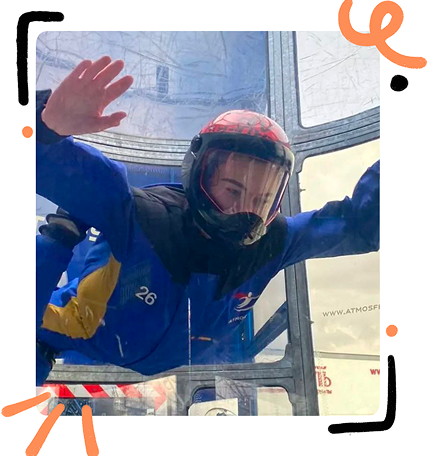
— Victoria, let’s talk about another important part of your life. Tell me, how did you meet your husband?
— My husband… he is incredible. For me, this is already my second marriage, and he probably became the first person who never leaves me alone, not even for a minute. And what’s most surprising — he accepts my “independence,” but at the same time doesn’t let me hide inside a cocoon. When I try to retreat into myself, he simply won’t let me go there. He just stays close. Doesn’t pressure me, doesn’t pull me, but holds me.
We met at my workplace. This person really impressed me. I don’t have legs, my kidneys are failing, but from the very first day, I saw admiration in his eyes. I have never met anyone more caring — he is my guardian angel. He is just there, and I don’t understand why. I’m not doing anything supernatural: I live as I can, I make mistakes, I share my experience.
— After those words, I don’t want to ask any questions. Still, I will: how accessible are modern prosthetics? Where is the line between “luxury” and necessity?
— You know, honestly, sometimes a company ends up at a loss on a prosthetic, because the amounts are universal, the same for everyone. And here the question arises: how can the same amount fit a person who walks 20–30 minutes a day and a 40-year-old man who works on the prosthetic?
The problem is that we are all equalized to a fixed minimum cost of the prosthetic, without understanding that everyone has their own needs. And people have to use what they are given, what happens to be available. And every time there’s a fight with yourself and with the system: either you take what they give, or you fight, prove your case, knock on doors, so the Social Insurance Fund allocates the needed amount. But often they just check off: “Prosthetic received,” and a couple of weeks later you’re back in surgery, because it’s simply impossible to live normally with that prosthetic.
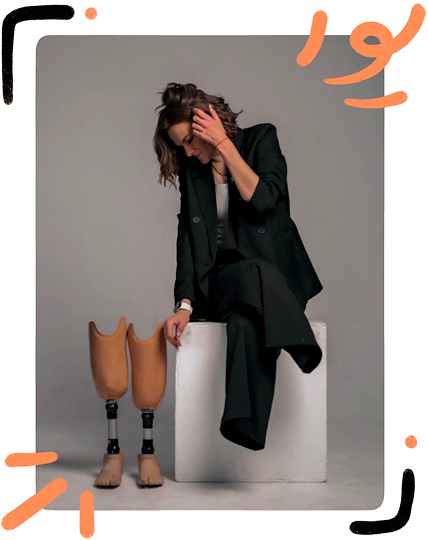
For example, I have feet with heel adjustment. Usually prosthetics are made for just one pair of shoes; even sneakers with different foot tilt are already a problem — you have to go to a technician to readjust the foot and adapt it for new shoes. Can you imagine?
I walked for two years in one pair of shoes, just buying identical sneakers in different colors. But wearing a skirt or a dress with them is impossible — it looks unaesthetic. Now, on my prosthetic foot, there is a button, and I can adjust it to the shoe. It’s such small details that change life.
— How wonderful that we started talking about this. How has your perception of yourself changed? What has become the most unexpected discovery?
— When I first got my prostheses, there was no culture of openness in Kaliningrad: everyone tried to hide them, wore wide pants so they wouldn’t be visible. I immediately decided I wouldn’t do that. My prostheses are my highlight, my charm. If people want to look — let them look. Do you have something that makes you unique? And be proud, because you didn’t give up, you keep living!
We had a man lying down: he couldn’t turn over, couldn’t sit up, he had lost one leg. And after 40 minutes of training, it turns out he’s already moving himself to the wheelchair, dressing himself, sitting down by himself. I look at the door, and his daughter peeks in with wide eyes: “Wait, you could do that?” I say: “Well, you should stay less around him, he will do everything himself.” Relatives always mean well, but if you love someone — think about what the person will do without you. What will happen to him? To her?
— So, there really is a difference in rehabilitation between men and women?
— This might sound harsh, but in 90% of cases men give up and lose their sense of purpose. Women, it’s like something clicks inside them: they start moving, fighting, achieving.
I want to connect these two worlds — so men wouldn’t be afraid, so they’d meet new people, so they wouldn’t feel like outcasts. Are we not human? Going out into this world is scary, but all my guys I worked with are already working, studying, living.
— Do you continue supporting your protégés after the sessions?
— Yes, I don’t forget anyone. If someone leaves the gym, I call afterwards and ask: “How are you? How’s walking? Working? You promised me you’d achieve something. Did you? Why not?” It’s important to me that a person begins to live a full, rich, interesting life. That their goal becomes the engine.
— Victoria, our conversation is coming to an end. I thank you for letting us look where people usually aren’t invited, and doing it with a smile. I want to ask you the question we started with: what would you want people to remember after meeting you?
— You should never stop at what you have achieved. In any situation, even the most hopeless, there is always a way out. You can give yourself time: a day, two, to unload, cry, whine, feel sorry for yourself, but then you need to pull yourself together and move forward. Once I thought that without legs there was no future, and now my prostheses practically run cross-country at rehabilitation workshops and give new life to other people.
Every person can handle what is given to them. I’m not as strong as everyone thinks, I just live — I have no other choice. I tried to die, but they brought me back, so I must live. As long as life gives you a chance — live. Take today and make one small victory in it: call someone you owe an apology to, start a course you postponed for years, hug the person next to you. Life is not a marathon, it’s a million tiny steps. Never think about what will happen tomorrow or the day after. Live here and now. Don’t postpone problems, solve them immediately. Achieve.
We need each other. When I help a patient stand on their feet, they help me find new meaning, make another discovery, and that is when a miracle happens. So remember: if I managed to find happiness after a double amputation — your dreams are definitely worth fighting for. Shall we live?
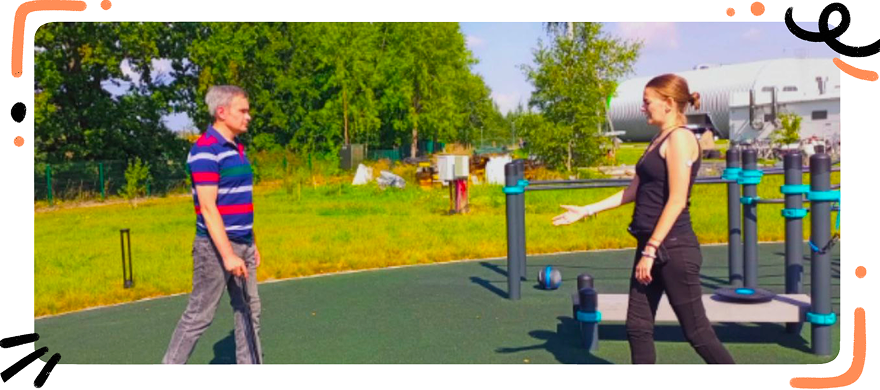
The micro world makes particles dance to the melody of probability.
Thank you!


